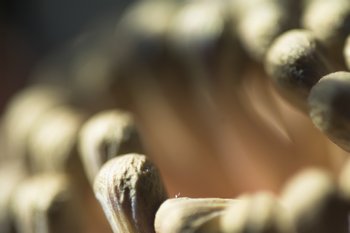|
|

In 1987, flax oil made with health in mind hit the market in North America.
It was my brainchild, developed over several years out of the personal desperation that followed pesticide poisoning in 1980. To make it, I had to first invent methods for making oils with health rather than shelf life in mind. That same week, one of the fish oil suppliers began a turf-protecting controversy that has been circulating ever since. ‘The body cannot convert flax oil into fish oils,’ the story told by this fish oil supplier went.
It was not true then, and is not true now, because there is research that shows that, provided there is enough starting material (flax, flax oil, or the plant-based omega 3 essential fatty acid, ALA) in the diet, its conversion to EPA and DPA is quite good in both men and women, and in women, conversion from ALA to DHA is also quite good. ALA to DHA conversion in men is slower.
What is not pointed out in the advertising done by fish oil suppliers is that this research measured conversion in the body, not in the brain. Brain conversion of ALA to DHA has not been measured, because few volunteers agree to have brain biopsies taken (drill a hole in your head; take out samples of brain tissue) to measure brain conversion of ALA to DHA.
 When a woman gets pregnant, she has to provide DHA for the child’s rapidly developing brain during its most active brain growth phase. Ditto when she breastfeeds the baby. If she cannot make DHA in her body, DHA has to be carted from her brain to her uterus/breasts to build the brain of her fetus/infant. If this becomes necessary, her brain is depleted of DHA, and memory problems, low energy levels, and depression may follow. When a woman gets pregnant, she has to provide DHA for the child’s rapidly developing brain during its most active brain growth phase. Ditto when she breastfeeds the baby. If she cannot make DHA in her body, DHA has to be carted from her brain to her uterus/breasts to build the brain of her fetus/infant. If this becomes necessary, her brain is depleted of DHA, and memory problems, low energy levels, and depression may follow.
For mother’s brain health, it is best to not have to remove DHA from that organ during pregnancy and breastfeeding. If mom gets enough ALA in her diet, she can convert this to DHA in her liver, and to supply this important building block for the child’s brain via uterus and breasts.
Men hardly ever get pregnant, so the body conversion of ALA to DHA is not necessary and not useful. That is why men don’t convert ALA to DHA in their body. There would be no point to it. Unfortunately, the marketing reality we have to face is that no matter how often this is explained, it will not change the story of those whose livelihood depends on convincing us that we’ve gotta have fish oil in our diet.
 There is a profoundly simple reason why even good fish oils are not enough. There is a profoundly simple reason why even good fish oils are not enough.
Humans need a lot (more than 15%, and less than 60% of calories) of fat in their diet. Dogs, cats, and wild carnivores need much less. Cows, horses, and their wild cousins need even less.
Do you know what is the average daily total fat intake of a normal adult?
The average adults daily intake of fat is about 100 grams. Canadians eat a little less than Americans. Ozzie and Kiwi fat intake is about the same.
Do you know how much of total daily fat intake comes from fish oil?
 The usual recommended daily dose of fish oil is 3 to 5 grams. That 5 grams of fish oil equals 2.25% of calories in a 2,000-calorie diet. That is not enough fat for human requirement. Even 10% of calories is too little fat, and leads to dry skin, low energy, and deterioration of health. The bottom end of adequate fat intake is 15% of calories. If all of that came from fish oil, we would need to take 33 grams of fish oil, or slurp more than 2 tablespoons of fish oil off a 15ml spoon. The usual recommended daily dose of fish oil is 3 to 5 grams. That 5 grams of fish oil equals 2.25% of calories in a 2,000-calorie diet. That is not enough fat for human requirement. Even 10% of calories is too little fat, and leads to dry skin, low energy, and deterioration of health. The bottom end of adequate fat intake is 15% of calories. If all of that came from fish oil, we would need to take 33 grams of fish oil, or slurp more than 2 tablespoons of fish oil off a 15ml spoon.
That much fish oil can cause bleeding problems. That much fish oil can also increase inflammation. My opinion is that PCBs, dioxins, and other industrial toxins, as well as processing-damaged molecules, which often make up as much as 3-5% or even more of the total fish oil, cause this problem. The only fish oil that I know to be undamaged and free of toxic industrial molecules is CO2-extracted fish oil. Of course, the sustainability issue is not addressed even by CO2-extracted fish oil, but at least it does not harm us.
Oils that have been deodorized or molecularly distilled have been heated to high temperatures, and most of these fish oils have been treated with caustic soda and acid, as well as being bleached. They are more damaged by this processing than cooking oils that have been similarly treated. Fish oil omega 3s (EPA and DHA) are about 25 times more sensitive to damage done by light, oxygen, and heat than are the much more stable omega 6-containing nut and seed oils.
- First, our brain, which is mostly made of fat (we are fat-heads after all, and it’s a compliment), is substantially larger than that of most
other brained creatures.
- Second, we lack fur, so fat under our skin is required for insulation as well as cushioning.
- Third, being naked, we burn fat to keep our body warm. To that end, we burn more fat in the cold of winter than in the heat of summer.

Fish oils make up only a very small part
of the fat we need to consume on a daily basis.
How small? Lets do the math.
95 of the 100 grams of fats
we consume each day
are foundation fats.
What are foundation fats? Foundation fats are the fats we get in
the foods we eat. Most of those fats come from seeds, nuts, meat, dairy products, eggs, and seed/nut oils. They include plant fats as
well as animal fats.
Everyone must have enough foundation fats. They are major nutrients. We need them in large quantities, along with protein and
carbohydrates. Together, these three—proteins, fats, and carbohydrates (arguably, we could add water, greens, and oxygen to the
list)—are sometimes called the ‘pillars of nutrition’ in college nutrition textbooks. They are our bulk nutrients. We need larger amounts
of these nutrients than we need of minerals, of vitamins, of antioxidants, or of phytonutrients. We need more of them than we need of
fiber, of enzymes, or of probiotics.
We can call the remaining 5 grams of fat we consume supplement fats. These usually come from fish oils, but there are other, better
(because cleaner and less damaged) sources of supplement fats, including CO2-extracted fish oils (Minami Nutrition), krill oil (intensely
smelly), and unrefined algae oil (the newest, cleanest, undamaged, plant-based, exclusive to FMD and Flora Manufacturing and
Distributing [not the Flora margarine people!).
And here is what we need to get clear
regarding fat consumption for optimum health:
-
All human being must have enough foundation fats.
-
Some will get better results if they add supplement fats to their foundation fats.
-
None can maintain good health on supplement fats alone.

Fish Don’t Make Fish Oils!
That’s right. Fish don’t make fish oils. How do we know that?
When salmon farming began in North America, farmers discovered that without fish oil in their diet, farmed salmon did not contain
salmon oil in their tissues. They also found out that salmon could not turn vegetable, seed, and nut oils into fish oils. Research shows
that carnivorous fish (75% of the fish we eat) including salmon cannot convert ALA into EPA and DHA. Plant-eating (vegetarian) fish
are able do this conversion.
 They get their ‘fish oil’ from the foods they eat. When we trace these supplement oils back to their origin, we find that the oils we call
‘fish oils’ are actually made by plants at the bottom of the food chain. One-celled red-brown algae make fish oils. Fish oils are actually
plant-based products. They get their ‘fish oil’ from the foods they eat. When we trace these supplement oils back to their origin, we find that the oils we call
‘fish oils’ are actually made by plants at the bottom of the food chain. One-celled red-brown algae make fish oils. Fish oils are actually
plant-based products.
Something eats these red-brown algae. Something eats what ate the algae. Something else eats that. Little fish eat that. Big fish eat
little fish. Whales and seals eat big fish. Polar bears eat seals. We nibble on all parts of the food chain.
And that is how supplement oils, made by lowly, humble, one-celled plants, find their way into all parts of the entire food chain.
In the ocean, red-brown algae only contain about 4% of their weight as supplement omega 3s: DHA, DPA, and EPA. We cannot press
oil out of these microscopically small plants, simply because there’s not enough oil in them to squeeze. There would have to be at least
15% oil to make squeezing possible.
Grow them in tanks & super-feed them.

Tanks are a controlled environment that is free of PCBs, dioxins, and pesticides. That solves one of the major
objections to using fish oils. We can super-feed these algae so that they contain 50% oil. We can then remove the oil without doing
damage to it, which gets us unrefined supplement oil.
That solves the second objection to using fish oils. We can grow red-brown algae in
tanks. We do not deplete fish stocks. Our method is sustainable.
If we need more, we just build more tanks to grow them in. This solves
the third (sustainability) objection to using fish oils.
This is the basis for Udo’s products — to provide quality nutrition in harmony with nature!
Our standards for foundation oil include:
-
Made with health (undamaged) rather than shelf life (damaged) in mind.
- Made from organically grown seeds free of pesticides and industrial toxins.
- No harsh chemicals and high heat are used, preventing damage to the sensitive molecules.
- Rich in omega 3s, which are highly sensitive and too low in most people’s food supply and intake.
- Omega 3 and 6, both essential, are in the most effective balance.
- Both omega 3 and omega 6 essential foundation oils are made under protection from light, oxygen, and heat to keep them
intact, in their natural state, and undamaged.
- Packaged in glass, because plastic can leach into oils even more rapidly than into water.
Our standards for supplement oil include:
- The algal oils we use are of the same high standards that we set for foundation oils.
- Both foundation and supplement oils are free of pesticides, PCBs, and dioxins.
- We use supplement oils that are undamaged by processing.
I hope that this helps to remove the confusion
in the oils arena,
making it clear
why even good fish oils are NOT enough.
Now is the time to set higher standards
in your pursuit of better health,
and to choose the right fats in adequate amounts
for optimal results!
“Udo’s Choice — quality nutrition in
harmony with nature
since the 1980’s”

|
|